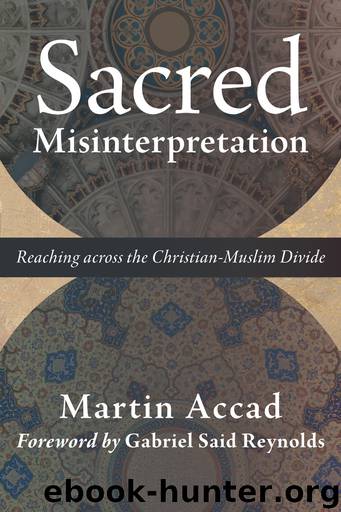Sacred Misinterpretation by Accad Martin; Reynolds Gabriel Said;

Author:Accad, Martin; Reynolds, Gabriel Said;
Language: eng
Format: epub
Publisher: William B. Eerdmans Publishing Company
The Soteriological Implications of the Muslim Approach to Christ
We can conclude from these two chapters on Christ that the Christian doctrine most negatively affected by the Islamic attack against Christ’s divine nature is soteriology. It is the central concern for the salvific benefits of Christ’s incarnation that always united the different Christian factions precisely in their very disagreements. Fourth- and fifth-century theologians in Alexandria emphasized Christ’s divinity, leading to the affirmation of the one divine nature in the person of Christ (miaphysite or so-called Jacobite Christology). Only God himself, it was affirmed, could carry out human salvation. In Antioch, on the other hand, theologians emphasized Christ’s full and very real humanity, in the belief that whatever part of the human person was not crucified with Jesus on the cross would have failed to be redeemed (diaphysite or so-called Nestorian Christology). In the end, the Council of Chalcedon in 451 emphasized both natures equally, albeit somewhat artificially, in recognition of the importance of both of these elements for human salvation to be complete.
To the Muslim mind, the very idea that God would go to such lengths in order to achieve a salvation that was in any case entirely up to his omnipotent will represented the height of absurdity. He could simply have said kun (“let it be”), fa-yakun (and it would have happened). Muslim theologians therefore launched a most virulent attack against this doctrine. The most popular Gospel passage that they used to build their attack was the account of Jesus’s temptation. They derived both external and internal evidence from Matthew 4:1–11. Externally, they believed that the very occurrence of the temptation testified against Christ’s divinity. Internally, the replies that Jesus made to the devil reflected his state of submission.
Besides pointing to Christ’s hunger as an argument for his real humanity (Matt 4:3–4), aṭ-Ṭabarī also concluded on the basis of the whole episode (4:1–11) that if the Christian view about Christ were applied to this passage, this would imply that the eternal creator would have walked alongside the devil, followed him, and been tempted by him. Otherwise, assuming that even Christians would shrink before such an implication, then it is clear that this person tempted by the devil was not God himself, and hence the Christian faith falls apart. He concludes: “And if the one who walked and was led alongside him [the devil] was not the eternal creator, then he is a servant, son of his mother.”
Aṭ-Ṭabarī’s narration of the account does not represent the devil approaching Christ after he had fasted forty days, but rather throughout the forty days. His citation of Matthew 4:2 reads as follows: “And he kept on walking alongside the devil [ẓalla yataraddadu maʿ ash-shayṭān] in the desert, fasting forty days and forty nights.”38
This rendering would play a crucial role in the future development of the exegesis of this passage in Muslim treatises, especially in connection with soteriology. Already in connection with his narration of Christ’s temptation, ʿAlī aṭ-Ṭabarī raises a criticism against the Christian view of soteriology.
Download
This site does not store any files on its server. We only index and link to content provided by other sites. Please contact the content providers to delete copyright contents if any and email us, we'll remove relevant links or contents immediately.
| Hadith | History |
| Law | Mecca |
| Muhammed | Quran |
| Rituals & Practice | Shi'ism |
| Sufism | Sunnism |
| Theology | Women in Islam |
The History of Jihad: From Muhammad to ISIS by Spencer Robert(2572)
Nine Parts of Desire by Geraldine Brooks(2326)
The Turkish Psychedelic Explosion by Daniel Spicer(2314)
The First Muslim The Story of Muhammad by Lesley Hazleton(2219)
The Essential Rumi by Coleman Barks(1992)
1453 by Roger Crowley(1965)
The Last Mughal by William Dalrymple(1831)
Trickster Travels: A Sixteenth-Century Muslim Between Worlds by Davis Natalie Zemon(1815)
God by Aslan Reza(1614)
Muhammad: His Life Based on the Earliest Sources by Martin Lings(1608)
by Christianity & Islam(1595)
A Concise History of Sunnis and Shi'is by John McHugo(1547)
Magic and Divination in Early Islam by Emilie Savage-Smith;(1500)
No God But God by Reza Aslan(1495)
The Flight of the Intellectuals by Berman Paul(1465)
Art of Betrayal by Gordon Corera(1403)
Nothing to Envy by Barbara Demick(1387)
What the Qur'an Meant by Garry Wills(1363)
Getting Jesus Right: How Muslims Get Jesus and Islam Wrong by James A Beverley & Craig A Evans(1311)
